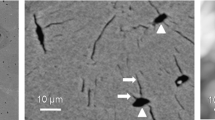Summary
Cortical bone, at the osteonal level, consists of three phases: mineral, organic, and pore or void phases. In osteonal segments excised from mature human cortical bone, organic volume percent is a constant. Determination of the mineral and organic phase densities present in these segments has led to defining a simple relationship between percent mineralization and void volume. Studies of a group of osteonal segments from 5 human tibias suggest that porosity of up to 22.7% may exist. This is much more than is suggested by histological examination, leading to the conclusion that the majority of the void phase is present as a dispersed porosity.
Similar content being viewed by others
References
Brown, W. E.: Crystal growth of bone mineral, Clin. Orthor. Rel. Res.,44, 205–220, 1966
Eastoe, J. E., Eastoe, B.: The organic constituents of mammalian compact bone, Biochem. J.57:453–59, 1954
Strandh, J.: Microchemical studies on single haversian systems. I. Methodological considerations with special reference to variations in mineral content, Exp. Cell Res.19:515–520, 1960
Davies, H. G., Engstrom, A.: Interferometric and X-ray absorption studies of bone tissue, Exp. Cell Res.7:243–55, 1954
Black, J.: Dead or alive: the problem of in vitro tissue mechanics, J. Biomed. Mater. Res.10:377–390, 1976
Black, J., Mattson, R. U.: The relationship between porosity and mineralization in the haversian osteon segment, Trans. ORS5:229, 1980
Woessner, J. F. J.: Determination of hydroxyproline in tissue and protein samples containing a small proportion of this amino acid, Arch. Biochem. Biophys.93:440–447, 1961
Neuman, R. E., Logan, M. A.: The determination of collagen and elastin in tissues, J. Biol. Chem.186:549–556, 1950
Boyde, A.: Scanning electron microscope studies of bone. In: G. H. Bourne (ed.): The Biochemistry and Physiology of Bone, Vol. 1, pp. 259–310. Academic Press, New York, 1972
Currey, J. D.: Mechanical consequences of variation in mineral content of bone, J. Biomechan.2:1–11, 1969
Vose, G. P., Kubala, A. L.: Bone strength—its relationship to X-ray determined ash content, Hum. Biol.31:262–270, 1959
Mattson, R. U., Black, J., Richardson, S. R., Pollack, S. R.: Dynamic compressive modulus of human haversian osteons, Trans. ORS5:56, 1980
Kornblum, S. S., Kelly, P. J.: The lacunae and haversian canals in tibial bone from ischemic and non-ischemic limbs, J. Bone Joint Surg.46A:797–810, 1964
Amprino, R., Engstrom, A.: Studies on X-ray absorption and diffraction of bone tissue, Acta Anat. (Basel)15:1–22, 1952
Robinson, R. A.: Chemical analysis and electron microscopy of bone. In Rodahl, K., Nicholson, J. T., Brown, E. M., Jr. (eds): Bone As a Tissue, pp. 186–250. McGraw-Hill, New York, 1960
Author information
Authors and Affiliations
Rights and permissions
About this article
Cite this article
Black, J., Mattson, R.U. Relationship between porosity and mineralization in the haversian osteon. Calcif Tissue Int 34, 332–336 (1982). https://doi.org/10.1007/BF02411263
Issue Date:
DOI: https://doi.org/10.1007/BF02411263




